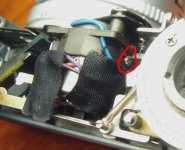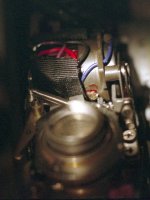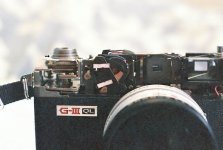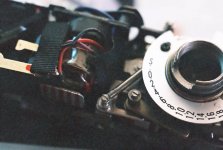dmr
Registered Abuser
I'm gonna write this up in depth, in case anybody else wants to try this, but here's a preliminary report.
I love the QL17 GIII, but one of the minor quirks is that the highest ASA/ISO it is intended to work with, at least for auto exposure, is 800. Since this is now my main low-light camera, I really wanted to be able to use the Fuji 1600 film in it.
To make a long story long ... I've wanted to try this for over a year. I've put it off, figuring that it's not really broken, so why fix it, but yes, it had a shortcoming which I did not like. Well, on Sunday, I thought hard, took a deep breath, said "what the {heck}" and very carefully proceeded to intentionally mis-calibrate it by about one F-stop.
The good news is that it appears to have worked! 🙂
The bad news is that I STILL really have NO CLUE as to how accurate the exposure is, in reference to any standards. All I really have to go on is the way the negatives look, which look quite normal. I do plan to shoot a roll of Kodachrome, carefully bracketing, in order to get more of an idea where it really is. The only thing I really have to compare it with is the Pentax, and there are differences, as much as an F-stop, at various points on the scale. I really don't know which is closer to being really accurate. My light sources were an east facing window and a blank wall in the bathroom with lights on dimmers.
But anyway ... my first test was to shoot a "control" roll of film, in this case the Walgreens/Fuji 200, as a sanity check to be sure it (still) worked properly under normal light with more of a normal film. I did this yesterday, late afternoon to early evening. This was, of course, now exposed with the setting of 100, but in actuality 200. Yes, the majority of the shots looked quite "normal" on the negatives. The first 2 below are from the "control" sanity check roll.
The real test, however, was to wait until dusk and try some Fuji 1600 and see how it looks. I admit I was a bit impatient (the way-ayy-ting is the hardest part) so I started shooting this just about as soon as the street lights came on. As I went to drive home (about 10:00pm) I was thinking that I should have waited until it was more dark-dark, but now I'm glad I didn't, since the twilight and afterglow gave more of a "normal" light and it showed that the metering was indeed working close to normal for that range of light. I do like to shoot urban night scenes under darker conditions, but this was a real good test of the metering.
The last 3 below are from the roll of 1600. They actually look like there's more light there than there was. The one of the front of the restaurant was close to wide open at 1/30 and you can see the detail of the inside of the restaurant clearly. (In the full size one, it looks like I attracted the attention of the 2 diners up front.) 🙂
Anyway, I'm quite optimistic about the success of the "surgery" on this camera. 🙂
Oops, it looks like I can no longer attach 5 images to a message. 🙁 I'm not sure whether this is the new software or some limit that the Powers That Be have imposed on the plebean users, but anyway, attached are one of the sanity check images and 2 of the actual 1600 test roll images. 🙁
I love the QL17 GIII, but one of the minor quirks is that the highest ASA/ISO it is intended to work with, at least for auto exposure, is 800. Since this is now my main low-light camera, I really wanted to be able to use the Fuji 1600 film in it.
To make a long story long ... I've wanted to try this for over a year. I've put it off, figuring that it's not really broken, so why fix it, but yes, it had a shortcoming which I did not like. Well, on Sunday, I thought hard, took a deep breath, said "what the {heck}" and very carefully proceeded to intentionally mis-calibrate it by about one F-stop.
The good news is that it appears to have worked! 🙂
The bad news is that I STILL really have NO CLUE as to how accurate the exposure is, in reference to any standards. All I really have to go on is the way the negatives look, which look quite normal. I do plan to shoot a roll of Kodachrome, carefully bracketing, in order to get more of an idea where it really is. The only thing I really have to compare it with is the Pentax, and there are differences, as much as an F-stop, at various points on the scale. I really don't know which is closer to being really accurate. My light sources were an east facing window and a blank wall in the bathroom with lights on dimmers.
But anyway ... my first test was to shoot a "control" roll of film, in this case the Walgreens/Fuji 200, as a sanity check to be sure it (still) worked properly under normal light with more of a normal film. I did this yesterday, late afternoon to early evening. This was, of course, now exposed with the setting of 100, but in actuality 200. Yes, the majority of the shots looked quite "normal" on the negatives. The first 2 below are from the "control" sanity check roll.
The real test, however, was to wait until dusk and try some Fuji 1600 and see how it looks. I admit I was a bit impatient (the way-ayy-ting is the hardest part) so I started shooting this just about as soon as the street lights came on. As I went to drive home (about 10:00pm) I was thinking that I should have waited until it was more dark-dark, but now I'm glad I didn't, since the twilight and afterglow gave more of a "normal" light and it showed that the metering was indeed working close to normal for that range of light. I do like to shoot urban night scenes under darker conditions, but this was a real good test of the metering.
The last 3 below are from the roll of 1600. They actually look like there's more light there than there was. The one of the front of the restaurant was close to wide open at 1/30 and you can see the detail of the inside of the restaurant clearly. (In the full size one, it looks like I attracted the attention of the 2 diners up front.) 🙂
Anyway, I'm quite optimistic about the success of the "surgery" on this camera. 🙂
Oops, it looks like I can no longer attach 5 images to a message. 🙁 I'm not sure whether this is the new software or some limit that the Powers That Be have imposed on the plebean users, but anyway, attached are one of the sanity check images and 2 of the actual 1600 test roll images. 🙁
Attachments
Last edited:








